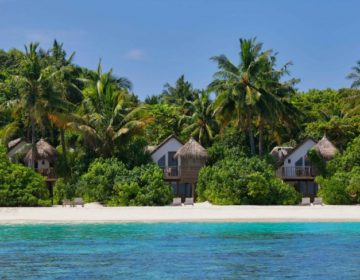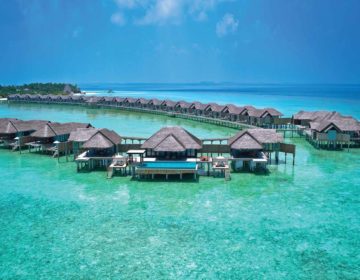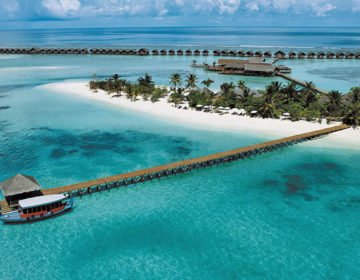Divers who expect an abundance of reef fish may be disappointed with Addu Atoll. But those who want to see wrecks, large manta rays, sharks, turtles, and generally big fish all year round, will be delighted with the diving. There are only four kandus in the atoll: Gan Kandu, Viligili Kandu, Maa Kandu, and Kuda Kandu. The channels have relatively few caves. Currents are generally not as strong as in the other tourist atolls so the channels can be dived at most times. Depths inside the atoll average around 35 meters, but it reaches a maximum of 75 meters in the middle. In the south of the Maldives, there are some differences in language, and the kandus are talked about as kandus, farus as faras and giris as galhas.

British Loyalty Shipwreck
History
The 5583-tonne oil tanker, British Loyalty was built in 1928 by Palmers Co. Ltd., Newcastle. The ship was torpedoed twice by enemy submarines during the war. The first time was by a Japanese midget submarine in Diego Suarez harbor, Madagascar on May 30th, 1942. It was damaged and taken to Addu Atoll in 1943 to be used as a storage hulk. She was torpedoed again in Addu Atoll on March 9th, 1944. The German U-183 submarine had ingeniously fired through a gap in the submarine nets blocking Gan Kandu. The ship was damaged but not sunk and remained there for the rest of the war. The Loyalty was finally scuttled on January 5th, 1946, before the British withdrew from Gan.
According to Mr. Mohammed Ibraheem Loutfi, who was a Maldivian liaison officer during the war, the ship was towed by tug to its present location and finally sunk by the guns of a British warship. Mr. Husain Didi from Hithadhoo, who was a 15-year-old boy at the time the ship was scuttled, said:
“There were many shots fired into the starboard side, and oil floated into the harbor killing some dolphins and fish. The oil continued to come ashore for about 10 years.”

Diving
The wreck lies 30 minutes by dhoni from Equator Village-Gan between the island of Maradhoo and Hithadhoo. It is lying on the starboard side, and the bottom is at around 33 meters. The port side is at 16 meters and the bow points almost directly north. The total length of the wreck is 140 meters, and its beam is 20 meters. Coral growth is excellent with large clumps of hard coral all over and a good covering of soft coral. At several places on the railing, big balls of coral look like natural fenders.
The propeller is at 28 meters and originally had four blades made of brass every two meters. Now the topmost blade is missing, but the remaining three are covered in big bushy black coral trees. In front of the engine room, about 60 meters from the stern are two large holes, one on the deck and the other on the keel. These are so big, divers can easily swim through from one side to the other. The holes were most likely caused when the torpedo exploded or when the vessel was sunk. Visibility averages around 20 meters. Schools of blue-fin jack and a large turtle swim around the deck, while on the upper side many smaller fish have found a home among the coral.

Demon Point Bay
At Koattey is a small inlet where day trips are made for introductory dives and a barbecue. It is a relaxing dive location with a relaxing atmosphere.
Gulda Lamago
This reef lies to the southeast of Koattey and is characterized by a steep slope decorated with hard coral and fine soft coral. There are some caves with lobsters, and at about 35 meters the reef undercuts itself to a sandy bottom at about 40 meters. This dive also has a reputation for sharks.
 There are some caves with lobsters on a a steep slope decorated with hard coral and fine soft coral.
There are some caves with lobsters on a a steep slope decorated with hard coral and fine soft coral.
Koatte Beyru West
On the outside reef near Fen Muli are a series of plateaus stepping down at different depths. There is plenty of fish life and between 20 and 30 meters are many white-tip and grey reef sharks. There are also Napoleon, schools of surgeon fish, barracuda, and sometimes manta rays. At 30 meters there is a steep drop-off. This dive can only be reached in calm weather and diving is sometimes strenuous due to strong currents.
Fihal Farru
This is a one-kilometer-long drift dive along the west side of Kuda Kandu. The reef extends well into the atoll and has big coral heads down the reef face to the bottom at 30 to 35 meters. Fish life includes big red bass, eagle rays, stingrays, and turtles.
 Fish life includes big red bass, eagle rays, stingrays, and turtles (above).
Fish life includes big red bass, eagle rays, stingrays, and turtles (above).
Bushy West
The reef on the west side of Kandu Huraa has a beautiful coral slope dropping to the bottom at 22 meters. There are large coral heads all down the slope, and nurse sharks are found sheltering among them. This is an easy drift dive that produces regular sightings of eagle rays, Napoleon and turtles.
Maa Kandu
There is a wide reef top on the outside reef corner between five and seven meters which offers a good start to the dive. Many different forms of acropora hard coral dominate the reef here. On the reef slope, which descends steeply from 12 meters, massive coral heads, large brain corals and spongy leather coral are a feature. Big manta rays are regularly seen at the corner.
Maa Kandu Beyru
The outside reef is an easy slow drift dive with a magnificent table and brain corals that is suitable for beginners. Schools of fusilier, turtles, eagle rays, and sometimes mantas make this beautiful reef and an absolute joy to dive.
Shark Point
On the northeast tip of Addu Atoll on the outside of Hulhumeedhoo is a spectacular shark dive. The outside reef drops from five to 30 meters to a sandy plateau that is about 30 meters wide. On this sand is the ‘shark hotel,’ where as many as 15 white tip sharks and five grey reef sharks can be seen at any one time. On the outside of the plateau, the reef drops to more than 60 meters and then the visibility is good, big sharks are seen swimming in the depths below.
 On the outside of the plateau, the reef drops to more than 60 meters and then the visibility is good, big sharks are seen swimming in the depths below.
On the outside of the plateau, the reef drops to more than 60 meters and then the visibility is good, big sharks are seen swimming in the depths below.
Las Pueblas
This dive is located on the outside reef of Heretere. It was named after the cliff cities of the natives in the American southwest as it has a steep wall with many small caves. The reef edge is at a depth of about 20 meters, and the wall drops to around 55 meters to a sandy plateau. On the outside of the plateau, well beyond the range of divers, is another wall. Turtles and barracuda feature here but this mostly a landscape dive.
Muli Kolhu Faru
The corner into Viligili Kandu is long and rounded with a gently sloping reef from five to 30 meters. Lying on the sandy bottom at about 35 meters is a large hollow steel ball, 2.5 meters in diameter. This was one of the buoys used for supporting the submarine net across Viligili Kandu. Big barracuda, white-tip reef sharks and huge manta rays up to four meters across, are common around the corner.
Two hundred meters further into the channel is a large chain starting at a steel anchor point on the reef edge at 15 meters and trailing to the bottom of the channel at about 34 meters. The chain has 20-centimeter-long links and was the primary support for the submarine net. Near the chain, mantas can be seen all year round making this the ‘manta point’ of Addu Atoll. There is also an overhang nearby that is a favorite resting place for nurse sharks. There are more overhangs inside the channel at 30 meters.
 Near the chain, mantas can be seen all year round making this the ‘manta point’ of Addu Atoll.
Near the chain, mantas can be seen all year round making this the ‘manta point’ of Addu Atoll.
Kanandhou Kaleyge Galha
There is a small reef inside Viligili Kandu ideal for night dives and beginner divers. The reef is half-moon in shape and has a beautiful coral garden on the eastern side. Coral heads protrude from the reef slope to the sandy bottom at 20 meters.
Viligili Inside
On the inside southern corner of Viligili Kandu is a finger of reef starting at eight meters and dropping to 20 meters. Divers can spend the whole dive going around this reef. Further south along the reef are shallow bays with pretty coral. At 10 meters is a steel boat about 12 meters long. Cables are also found running into the lagoon on this reef. On the bottom at 13 meters is a large steel ball with a chain that was once part of the submarine net across Viligili Kandu.
Gan Inside
Gan Inside is an ideal beginner’s dive near the eastern end of the airport runway. Towards the outside of Gan Kandu, there is a small wall starting at five meters. On the top of the reef are wide sandy corridors, sometimes with ten or more resting stingrays. There are also encounters with many hawksbill and green turtles.
Further inside the channel the reef slopes more gradually to 14 meters. The bottom is sandy with large coral boulders housing a wide variety of marine life. Here divers will find schools of pelagics like blue-fin jack and darts, also stingrays and eagle rays.
 Here divers will find schools of pelagics like blue-fin jack and darts, also stingrays and eagle rays (above).
Here divers will find schools of pelagics like blue-fin jack and darts, also stingrays and eagle rays (above).
(Source: Dive Maldives: A Guide to the Maldives Archipelago. Tim Godfrey. Atoll Editions, 2015)




czcn jdo tracking
[…] Addu Atoll in the Maldives is the perfect attraction for divers who are in search of shipwrecks, manta rays, sharks, sea […]